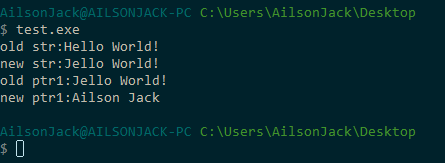C语言中#的神奇作用
<p style="text-indent: 2em;">C语言中,在宏里面的’#’和’##’有它非常神奇的作用,下面就来说说具体的用法。</p><p class="artical_littlestyle1">1、一般用法</p><p style="text-indent: 2em;">我们使用#把宏参数变为一个字符串,用##把两个宏参数贴合在一起。<br/></p><p style="text-indent: 2em;">下面的代码是演示代码:</p><pre class="brush:cpp;toolbar:false PrismJs">#include <stdio.h>
#define STRING(s) #s
#define CONNECT(a,b) int(a##e##b)
int main(void)
{
//输出字符串"abcdefg"
printf("string:%s\r\n",STRING(abcdefg));
//2e3输出:2000
printf("connect:%d\r\n",CONNECT(2,3));
return 0;
}</pre><p style="text-indent: 2em;">运行结果如下图:</p><p style="text-align:center"><img src="/uploads/AilsonJack/2018.08.25/1535188783353292.png" onclick="preview_image('/uploads/AilsonJack/2018.08.25/1535188783353292.png')"/></p><p class="artical_littlestyle2">2、当宏参数是另一个宏的时候</p><p style="text-indent: 2em;">需要注意的是凡是宏定义里有用'#'或'##'的地方宏参数是不会再展开。<br/><span style="background-color: rgb(118, 146, 60);">1)、</span>非’#’和’##’的情况 <br/><span style="color: rgb(0, 112, 192);">#define TOW (2)<br/>#define MUL(a,b) (a*b)<br/>printf(“%d*%d=%d\n”, TOW, TOW, MUL(TOW,TOW));</span><br/></p><p style="text-indent: 2em;">这行的宏会被展开为:<br/><span style="color: rgb(0, 112, 192);">printf(“%d*%d=%d\n”, (2), (2), ((2)*(2)));</span><br/></p><p style="text-indent: 2em;">MUL里的参数TOW会被展开为(2)。<br/><span style="background-color: rgb(118, 146, 60);">2)、</span>当有’#’或’##’的时候 <br/><span style="color: rgb(0, 112, 192);">#define A (2)<br/>#define STR(s) #s<br/>#define CONS(a,b) int(a##e##b)<br/>printf(“int max: %s\n”, STR(INT_MAX)); //INT_MAX 这行会被展开为:printf(“int max: %s\n”, “INT_MAX”);<br/>printf(“%s\n”, CONS(A, A)); //这一行则是:printf(“%s\n”, int(AeA));</span><br/></p><p style="text-indent: 2em;">INT_MAX和A都不会再被展开,然而解决这个问题的方法很简单。加多一层中间转换宏。加这层宏的用意是把所有宏的参数在这层里全部展开,那么在转换宏里的那一个宏(_STR)就能得到正确的宏参数。<br/><span style="color: rgb(0, 112, 192);">#define A (2)<br/>#define _STR(s) #s<br/>#define STR(s) _STR(s) //转换宏<br/>#define _CONS(a,b) int(a##e##b)<br/>#define CONS(a,b) _CONS(a,b) //转换宏<br/>printf(“int max: %s\n”, STR(INT_MAX)); // INT_MAX,int型的最大值,为一个变量</span><br/></p><p style="text-indent: 2em;">输出为: <span style="color: rgb(255, 0, 0);">int max: 0x7fffffff</span><span style="color: rgb(0, 0, 0);">,STR(INT_MAX) –> _STR(0x7fffffff)</span>然后再转换成字符串。<br/><span style="color: rgb(0, 112, 192);">printf(“%d\n”, CONS(A, A));</span><br/></p><p style="text-indent: 2em;">输出为:<span style="color: rgb(255, 0, 0);">200</span>,CONS(A, A) –> _CONS((2), (2)) –> int((2)e(2)) 。<br/></p><p class="artical_littlestyle3">3、'#'和'##'的一些应用特例</p><p style="text-indent: 0em;"><span style="background-color: rgb(118, 146, 60);">1)、</span>合并匿名变量名<br/><span style="color: rgb(0, 112, 192);">#define ___ANONYMOUS1(type,var,line) type var##line<br/>#define __ANONYMOUS0(type, line) ___ANONYMOUS1(type, _anonymous, line)<br/>#define ANONYMOUS(type) __ANONYMOUS0(type, __LINE__)</span><br/>例:ANONYMOUS(static int);即: static int _anonymous70;//70表示该行行号;<br/>第一层:<span style="color: rgb(0, 112, 192);">ANONYMOUS(static int);</span> <span style="color: rgb(255, 0, 0);">-></span> <span style="color: rgb(0, 112, 192);">__ANONYMOUS0(static int, __LINE__);</span><br/>第二 层:<span style="color: rgb(0, 112, 192);">__ANONYMOUS0(static int, __LINE__);</span> <span style="color: rgb(255, 0, 0);">-></span> <span style="color: rgb(0, 112, 192);">___ANONYMOUS1(static int, _anonymous, 70);</span><br/>第三层:<span style="color: rgb(0, 112, 192);">___ANONYMOUS1(static int, _anonymous, 70);</span> <span style="color: rgb(255, 0, 0);">-></span> <span style="color: rgb(0, 112, 192);">static int _anonymous70;</span><br/>即每次只能解开当前层的宏,所以__LINE__在第二层才能被解开<br/><span style="background-color: rgb(118, 146, 60);">2)、</span>记录文件名<br/><span style="color: rgb(0, 112, 192);">#define _GET_FILE_NAME(f) #f<br/>#define GET_FILE_NAME(f) _GET_FILE_NAME(f)<br/>static char FILE_NAME[] = GET_FILE_NAME(__FILE__); </span><br/></p><p style="text-indent: 2em;">其中2用得比较多,很方便。<br/></p>
暂无评论,要不要来个沙发
发表评论
![]()
![]()
![]()
![]()
![]()
![]()
![]()
![]()
![]()
![]()
![]()
![]()
![]()
![]()
![]()
![]()
![]()
![]()
![]()
![]()
![]()
![]()
JLink V9掉固件修复(灯不亮) 3Zephyr笔记2 - 在STM32F429上运行HelloWorld 2计算NandFlash要传入的行地址和列地址 1Linux MMC子系统 - 6.eMMC 5.1工作模式-设备识别模式 0Linux MMC子系统 - 5.eMMC 5.1工作模式-引导模式 0Linux MMC子系统 - 4.eMMC 5.1常用命令说明(2) 0
标签云
Linux嵌入式实用技巧ARM内核学习问题集合CC++编程语言阅读笔记汇编Linux内核完全注释Windows驱动开发计算机基础ARM11ARMv7-ASTM32IDESublimeLinux内核学习eMMCMMC子系统Ubuntu操作系统OfficeVMWareAPUEgccRTOS中断漫游世界随笔感悟开发工具软件应用编程VsCodearmccarmclang编译器ZephyrSPIJLink网卡驱动安装各种芯片库函数NFSμCOS内核sambaFlashUnix命令与脚本输入法Linux内核设计与实现gitRIFFWAVJATGFTPar8161安装centos有线上网μCGUI字库工程建立右键菜单网络文件系统Firefox百度NTFS文件系统CodeBlocksCentOS数据结构算法PhotoShop51KeilQTUltraEditscanfglibc宏定义UIDGID优先级娱乐天地SourceInsight磁盘扇区总线I2CPDFBComparePythonI2SFPUMakefileSWDCPUARP软件推荐FileZilla



